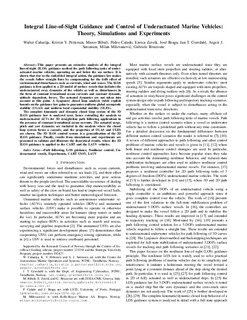| dc.contributor.author | Caharija, Walter | |
| dc.contributor.author | Pettersen, Kristin Ytterstad | |
| dc.contributor.author | Bibuli, Marco | |
| dc.contributor.author | Calado, Pável | |
| dc.contributor.author | Zereik, Enrica | |
| dc.contributor.author | Braga, Jose | |
| dc.contributor.author | Gravdahl, Jan Tommy | |
| dc.contributor.author | Sørensen, Asgeir Johan | |
| dc.contributor.author | Milovanovic, Milan | |
| dc.contributor.author | Bruzzone, Gabriele | |
| dc.date.accessioned | 2016-11-08T20:15:46Z | |
| dc.date.accessioned | 2016-11-11T13:14:30Z | |
| dc.date.available | 2016-11-08T20:15:46Z | |
| dc.date.available | 2016-11-11T13:14:30Z | |
| dc.date.issued | 2016 | |
| dc.identifier.citation | IEEE Transactions on Control Systems Technology 2016, 24(5):1623-1642 | nb_NO |
| dc.identifier.issn | 1063-6536 | |
| dc.identifier.uri | http://hdl.handle.net/11250/2420689 | |
| dc.description.abstract | This paper presents an extensive analysis of the integral line-of-sight (ILOS) guidance method for path-following tasks of underactuated marine vehicles, operating on and below the sea surface. It is shown that due to the embedded integral action, the guidance law makes the vessels follow straight lines by compensating for the drift effect of environmental disturbances, such as currents, wind, and waves. The ILOS guidance is first applied to a 2-D model of surface vessels that includes the underactauted sway dynamics of the vehicle as well as disturbances in the form of constant irrotational ocean currents and constant dynamic, attitude dependent, and forces. The actuated dynamics are not considered at this point. A Lyapunov closed-loop analysis yields explicit bounds on the guidance law gains to guarantee uniform global asymptotic stability (UGAS) and uniform local exponential stability (ULES). The complete kinematic and dynamic closed-loop system of the 3-D ILOS guidance law is analyzed in the following and hence extending the analysis to underactuated autonomous underwater vehicles (AUVs) for the 3-D straight-line path-following applications in the presence of constant irrotational ocean currents. The actuated surge, pitch, and yaw dynamics are included in the analysis where the closed-loop system forms a cascade, and the properties of UGAS and ULES are shown. The 3-D ILOS control system is a generalization of the 2-D ILOS guidance. Finally, results from simulations and experiments are presented to validate and illustrate the theoretical results, where the 2-D ILOS guidance is applied to the cooperative autonomous robotics towing system vehicle and light AUV. | nb_NO |
| dc.language.iso | eng | nb_NO |
| dc.publisher | Institute of Electrical and Electronics Engineers (IEEE) | nb_NO |
| dc.title | Integral Line-of-Sight Guidance and Control of Underactuated Marine Vehicles: Theory, Simulations and Experiments | nb_NO |
| dc.type | Journal article | nb_NO |
| dc.type | Peer reviewed | nb_NO |
| dc.date.updated | 2016-11-08T20:15:46Z | |
| dc.source.journal | IEEE Transactions on Control Systems Technology | nb_NO |
| dc.identifier.doi | 10.1109/TCST.2015.2504838 | |
| dc.identifier.cristin | 1397474 | |
| dc.relation.project | Norges forskningsråd: 223254 | nb_NO |
| dc.description.localcode | (c) 2016 IEEE. Personal use of this material is permitted. Permission from IEEE must be obtained for all other users, including reprinting/ republishing this material for advertising or promotional purposes, creating new collective works for resale or redistribution to servers or lists, or reuse of any copyrighted components of this work in other works | nb_NO |
